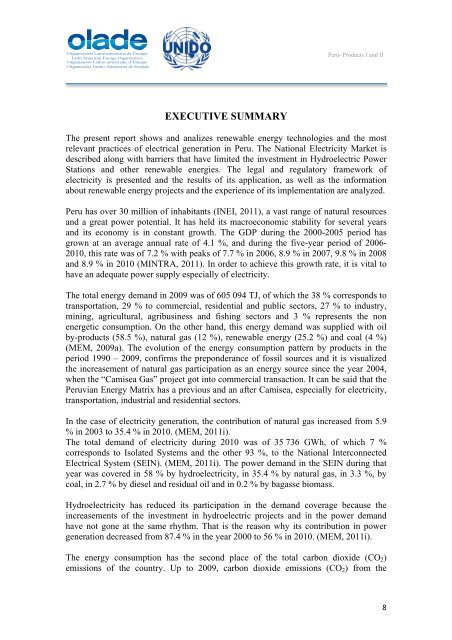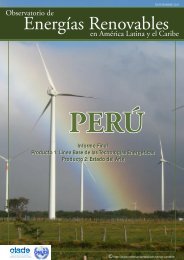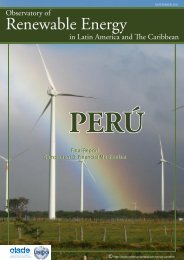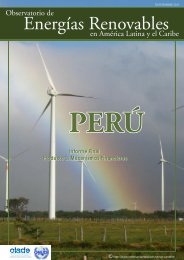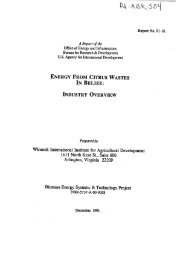PERÃ - Observatory for Renewable Energy in Latin America and
PERÃ - Observatory for Renewable Energy in Latin America and
PERÃ - Observatory for Renewable Energy in Latin America and
Create successful ePaper yourself
Turn your PDF publications into a flip-book with our unique Google optimized e-Paper software.
<br />
Perú- Products I <strong>and</strong> II<br />
<br />
EXECUTIVE SUMMARY<br />
The present report shows <strong>and</strong> analizes renewable energy technologies <strong>and</strong> the most<br />
relevant practices of electrical generation <strong>in</strong> Peru. The National Electricity Market is<br />
described along with barriers that have limited the <strong>in</strong>vestment <strong>in</strong> Hydroelectric Power<br />
Stations <strong>and</strong> other renewable energies. The legal <strong>and</strong> regulatory framework of<br />
electricity is presented <strong>and</strong> the results of its application, as well as the <strong>in</strong><strong>for</strong>mation<br />
about renewable energy projects <strong>and</strong> the experience of its implementation are analyzed.<br />
Peru has over 30 million of <strong>in</strong>habitants (INEI, 2011), a vast range of natural resources<br />
<strong>and</strong> a great power potential. It has held its macroeconomic stability <strong>for</strong> several years<br />
<strong>and</strong> its economy is <strong>in</strong> constant growth. The GDP dur<strong>in</strong>g the 2000-2005 period has<br />
grown at an average annual rate of 4.1 %, <strong>and</strong> dur<strong>in</strong>g the five-year period of 2006-<br />
2010, this rate was of 7.2 % with peaks of 7.7 % <strong>in</strong> 2006, 8.9 % <strong>in</strong> 2007, 9.8 % <strong>in</strong> 2008<br />
<strong>and</strong> 8.9 % <strong>in</strong> 2010 (MINTRA, 2011). In order to achieve this growth rate, it is vital to<br />
have an adequate power supply especially of electricity.<br />
The total energy dem<strong>and</strong> <strong>in</strong> 2009 was of 605 094 TJ, of which the 38 % corresponds to<br />
transportation, 29 % to commercial, residential <strong>and</strong> public sectors, 27 % to <strong>in</strong>dustry,<br />
m<strong>in</strong><strong>in</strong>g, agricultural, agribus<strong>in</strong>ess <strong>and</strong> fish<strong>in</strong>g sectors <strong>and</strong> 3 % represents the non<br />
energetic consumption. On the other h<strong>and</strong>, this energy dem<strong>and</strong> was supplied with oil<br />
by-products (58.5 %), natural gas (12 %), renewable energy (25.2 %) <strong>and</strong> coal (4 %)<br />
(MEM, 2009a). The evolution of the energy consumption pattern by products <strong>in</strong> the<br />
period 1990 – 2009, confirms the preponderance of fossil sources <strong>and</strong> it is visualized<br />
the <strong>in</strong>creasement of natural gas participation as an energy source s<strong>in</strong>ce the year 2004,<br />
when the “Camisea Gas” project got <strong>in</strong>to commercial transaction. It can be said that the<br />
Peruvian <strong>Energy</strong> Matrix has a previous <strong>and</strong> an after Camisea, especially <strong>for</strong> electricity,<br />
transportation, <strong>in</strong>dustrial <strong>and</strong> residential sectors.<br />
In the case of electricity generation, the contribution of natural gas <strong>in</strong>creased from 5.9<br />
% <strong>in</strong> 2003 to 35.4 % <strong>in</strong> 2010. (MEM, 2011i).<br />
The total dem<strong>and</strong> of electricity dur<strong>in</strong>g 2010 was of 35 736 GWh, of which 7 %<br />
corresponds to Isolated Systems <strong>and</strong> the other 93 %, to the National Interconnected<br />
Electrical System (SEIN). (MEM, 2011i). The power dem<strong>and</strong> <strong>in</strong> the SEIN dur<strong>in</strong>g that<br />
year was covered <strong>in</strong> 58 % by hydroelectricity, <strong>in</strong> 35.4 % by natural gas, <strong>in</strong> 3.3 %, by<br />
coal, <strong>in</strong> 2.7 % by diesel <strong>and</strong> residual oil <strong>and</strong> <strong>in</strong> 0.2 % by bagasse biomass.<br />
Hydroelectricity has reduced its participation <strong>in</strong> the dem<strong>and</strong> coverage because the<br />
<strong>in</strong>creasements of the <strong>in</strong>vestment <strong>in</strong> hydroelectric projects <strong>and</strong> <strong>in</strong> the power dem<strong>and</strong><br />
have not gone at the same rhythm. That is the reason why its contribution <strong>in</strong> power<br />
generation decreased from 87.4 % <strong>in</strong> the year 2000 to 56 % <strong>in</strong> 2010. (MEM, 2011i).<br />
The energy consumption has the second place of the total carbon dioxide (CO 2 )<br />
emissions of the country. Up to 2009, carbon dioxide emissions (CO 2 ) from the<br />
8


